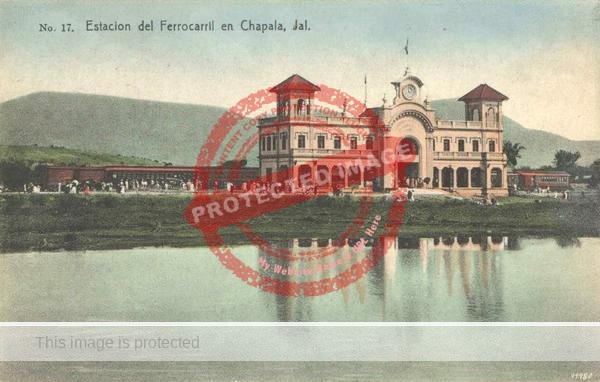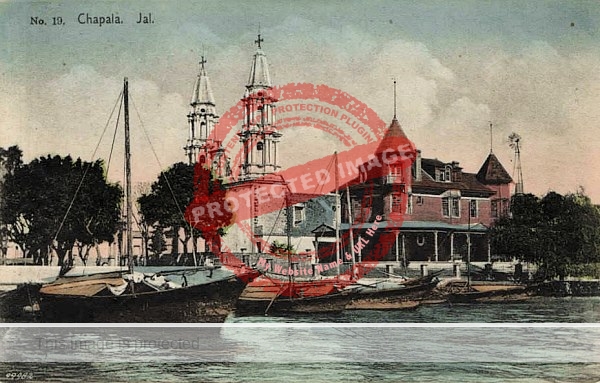A striking series of color-tinted postcards was published by S. Altamirano in the mid-1920s. The application of color on these cards was far more sophisticated than that used earlier by (among others) Alba y Fernández.
The reverse side of these cards carries the imprint, “Editor S. Altamirano, Av. Colon 165, Guadalajara.” The front of the cards includes a series number and caption, in black lettering as a single line, using both upper and lower case. The font used for the number is smaller than the font used for the caption.
Most Altamirano cards depict buildings in Guadalajara. But at least five cards in the series are related to Lake Chapala. They include (below) this carefully-composed view, from the lake, of Chapala’s majestic railroad station (now the Centro Cultural González Gallo). Carriages are visible behind a throng of excited passengers. Given that the railroad station was only in service from 1920 to 1926, this photograph must date from that period.

Romero / S. Altamirano. c 1925. Chapala Railroad Station.
Another Altamirano card shows the Hotel Arzapalo, as viewed from the main pier. A third, taken from almost the same vantage point, focuses on the San Francisco church and Casa Braniff; it has a line of cargo boats in the foreground. (For more about this house and its original owner, see Luis Pérez Verdía)

Romero ? / S. Altamirano. c 1925. San Francisco Church and Casa Braniff.
The fourth card in the series is an unusual view from the beach looking up to the castle-like Villa Montecarlo. The only other Altamirano card I have seen that relates to Chapala is a view of the famous trio of villas—Niza, Elena and Josefina—that caught the eye of so many different photographers over the years.
At least two of the photographs—the railroad station and the trio of villas— are definitely the work of a Guadalajara-based photographer named Romero. Romero took black and white photos and usually added “Romero Fot” and “Es propiedad” on them as a means of protecting his authorship. Presumably Altamirano and Romero had a commercial relationship, and it is more than possible that the other images published by Altamirano as color-tinted postcards were also originally by Romero.
One possible candidate for “S. Altamirano” is Guadalajara-born Salvador Altamirano Jiménez (1883-1939). He was a civil and electrical engineer, married first (in 1909) to Cecilia Martínez Cairo and then (1926) to Dolores Elizondo. Prior to the Mexican Revolution, he was an engineer in the Mexican armed forces. He also liked fast cars and was a member of the the Mexican Section of the American Institute of Electrical Engineers.
Each image on Altamirano postcards has a unique 5-digit number in tiny print at the bottom, sometimes in white, sometimes in black, depending on the tones in the photograph. These numbers are identical in style to the 5-digit numbers used by publisher Felix Martín of Mexico City. Martín’s postcards include one of the historic Villa Virginia in Chapala, and it seems likely that the two publishers had some kind of commercial connection.
My 2022 book Lake Chapala: A Postcard History uses reproductions of more than 150 vintage postcards to tell the incredible story of how Lake Chapala became an international tourist and retirement center.
Note: This post was first published 7 August 2023.
Sources
- La Iberia: diario de la mañana, 23 Jan 1910, 2.
- The Mexican Herald: 8 Nov 1912, 8; 6 December 1912.
- El Diario: 13 April 1914, 1.
Comments, corrections and additional material are welcome, whether via the comments feature or email.
Tony Burton’s books include “Lake Chapala: A Postcard History” (2022), “Foreign Footprints in Ajijic” (2022), “If Walls Could Talk: Chapala’s historic buildings and their former occupants” (2020), (available in translation as “Si Las Paredes Hablaran”), “Mexican Kaleidoscope” (2016), and “Lake Chapala Through the Ages” (2008).
beautiful cards and fascinating research–
Thanks, Bill.